Financial Accounting Assignment: Case Study Analysis and Report
VerifiedAdded on 2022/11/28
|25
|4323
|68
Homework Assignment
AI Summary
This financial accounting assignment presents a comprehensive analysis of key accounting concepts through two detailed scenarios. The solution includes journal entries, ledger accounts, trial balances, income statements, and balance sheets, providing a deep dive into double-entry bookkeeping, financial statement preparation, and the application of accounting principles. The assignment covers business transactions, the differences between financial reports and statements, and the roles of various stakeholders in financial reporting. It also delves into the fundamental principles of accounting, such as the matching principle, accrual principle, going concern, full disclosure, and revenue recognition, offering a practical understanding of their application. Furthermore, the solution includes a profit and loss account and a balance sheet, demonstrating the practical application of accounting knowledge. This document serves as a valuable resource for students studying financial accounting, offering insights into real-world applications and problem-solving techniques.
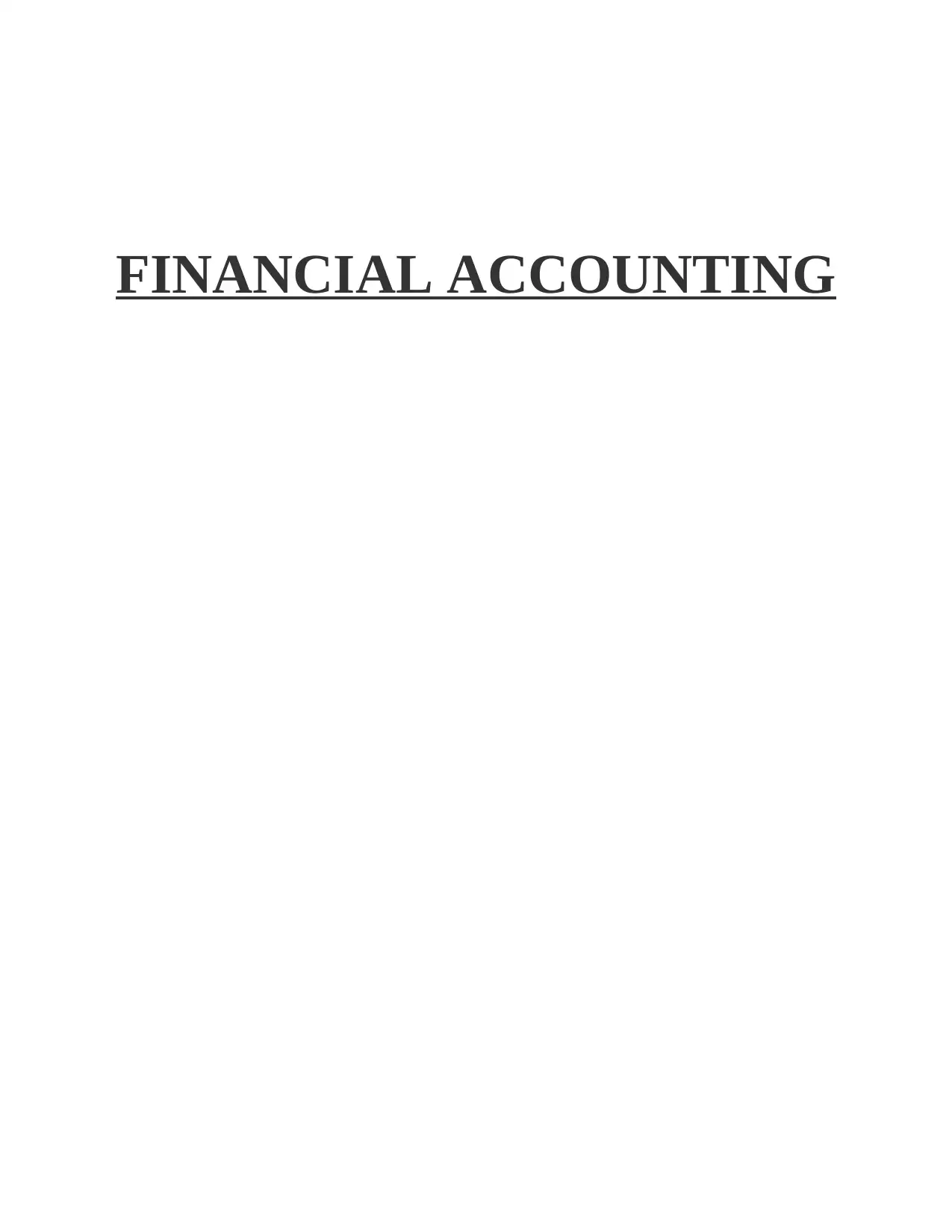
FINANCIAL ACCOUNTING
Paraphrase This Document
Need a fresh take? Get an instant paraphrase of this document with our AI Paraphraser
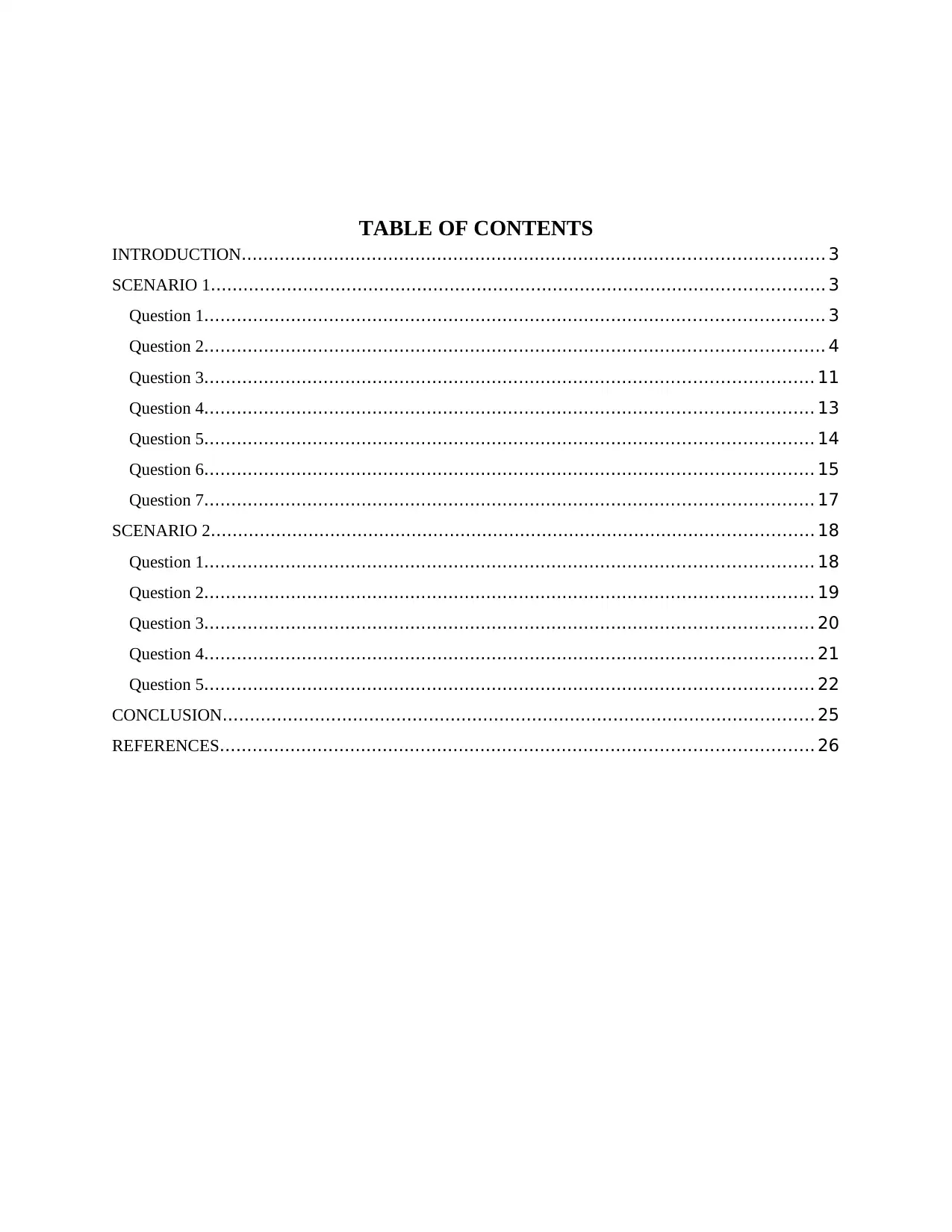
TABLE OF CONTENTS
INTRODUCTION........................................................................................................... 3
SCENARIO 1................................................................................................................. 3
Question 1.................................................................................................................. 3
Question 2.................................................................................................................. 4
Question 3................................................................................................................ 11
Question 4................................................................................................................ 13
Question 5................................................................................................................ 14
Question 6................................................................................................................ 15
Question 7................................................................................................................ 17
SCENARIO 2............................................................................................................... 18
Question 1................................................................................................................ 18
Question 2................................................................................................................ 19
Question 3................................................................................................................ 20
Question 4................................................................................................................ 21
Question 5................................................................................................................ 22
CONCLUSION............................................................................................................. 25
REFERENCES............................................................................................................. 26
INTRODUCTION........................................................................................................... 3
SCENARIO 1................................................................................................................. 3
Question 1.................................................................................................................. 3
Question 2.................................................................................................................. 4
Question 3................................................................................................................ 11
Question 4................................................................................................................ 13
Question 5................................................................................................................ 14
Question 6................................................................................................................ 15
Question 7................................................................................................................ 17
SCENARIO 2............................................................................................................... 18
Question 1................................................................................................................ 18
Question 2................................................................................................................ 19
Question 3................................................................................................................ 20
Question 4................................................................................................................ 21
Question 5................................................................................................................ 22
CONCLUSION............................................................................................................. 25
REFERENCES............................................................................................................. 26
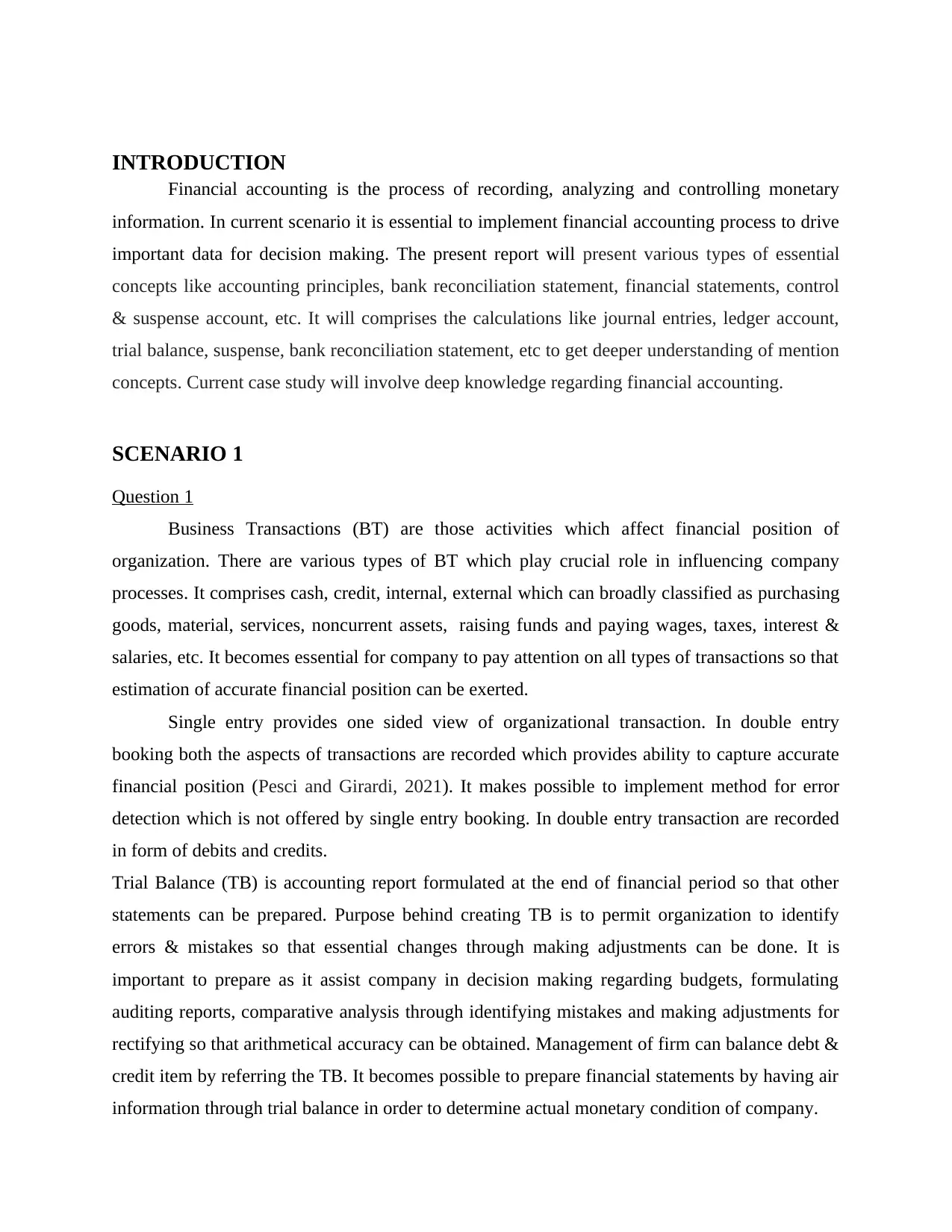
INTRODUCTION
Financial accounting is the process of recording, analyzing and controlling monetary
information. In current scenario it is essential to implement financial accounting process to drive
important data for decision making. The present report will present various types of essential
concepts like accounting principles, bank reconciliation statement, financial statements, control
& suspense account, etc. It will comprises the calculations like journal entries, ledger account,
trial balance, suspense, bank reconciliation statement, etc to get deeper understanding of mention
concepts. Current case study will involve deep knowledge regarding financial accounting.
SCENARIO 1
Question 1
Business Transactions (BT) are those activities which affect financial position of
organization. There are various types of BT which play crucial role in influencing company
processes. It comprises cash, credit, internal, external which can broadly classified as purchasing
goods, material, services, noncurrent assets, raising funds and paying wages, taxes, interest &
salaries, etc. It becomes essential for company to pay attention on all types of transactions so that
estimation of accurate financial position can be exerted.
Single entry provides one sided view of organizational transaction. In double entry
booking both the aspects of transactions are recorded which provides ability to capture accurate
financial position (Pesci and Girardi, 2021). It makes possible to implement method for error
detection which is not offered by single entry booking. In double entry transaction are recorded
in form of debits and credits.
Trial Balance (TB) is accounting report formulated at the end of financial period so that other
statements can be prepared. Purpose behind creating TB is to permit organization to identify
errors & mistakes so that essential changes through making adjustments can be done. It is
important to prepare as it assist company in decision making regarding budgets, formulating
auditing reports, comparative analysis through identifying mistakes and making adjustments for
rectifying so that arithmetical accuracy can be obtained. Management of firm can balance debt &
credit item by referring the TB. It becomes possible to prepare financial statements by having air
information through trial balance in order to determine actual monetary condition of company.
Financial accounting is the process of recording, analyzing and controlling monetary
information. In current scenario it is essential to implement financial accounting process to drive
important data for decision making. The present report will present various types of essential
concepts like accounting principles, bank reconciliation statement, financial statements, control
& suspense account, etc. It will comprises the calculations like journal entries, ledger account,
trial balance, suspense, bank reconciliation statement, etc to get deeper understanding of mention
concepts. Current case study will involve deep knowledge regarding financial accounting.
SCENARIO 1
Question 1
Business Transactions (BT) are those activities which affect financial position of
organization. There are various types of BT which play crucial role in influencing company
processes. It comprises cash, credit, internal, external which can broadly classified as purchasing
goods, material, services, noncurrent assets, raising funds and paying wages, taxes, interest &
salaries, etc. It becomes essential for company to pay attention on all types of transactions so that
estimation of accurate financial position can be exerted.
Single entry provides one sided view of organizational transaction. In double entry
booking both the aspects of transactions are recorded which provides ability to capture accurate
financial position (Pesci and Girardi, 2021). It makes possible to implement method for error
detection which is not offered by single entry booking. In double entry transaction are recorded
in form of debits and credits.
Trial Balance (TB) is accounting report formulated at the end of financial period so that other
statements can be prepared. Purpose behind creating TB is to permit organization to identify
errors & mistakes so that essential changes through making adjustments can be done. It is
important to prepare as it assist company in decision making regarding budgets, formulating
auditing reports, comparative analysis through identifying mistakes and making adjustments for
rectifying so that arithmetical accuracy can be obtained. Management of firm can balance debt &
credit item by referring the TB. It becomes possible to prepare financial statements by having air
information through trial balance in order to determine actual monetary condition of company.
⊘ This is a preview!⊘
Do you want full access?
Subscribe today to unlock all pages.

Trusted by 1+ million students worldwide
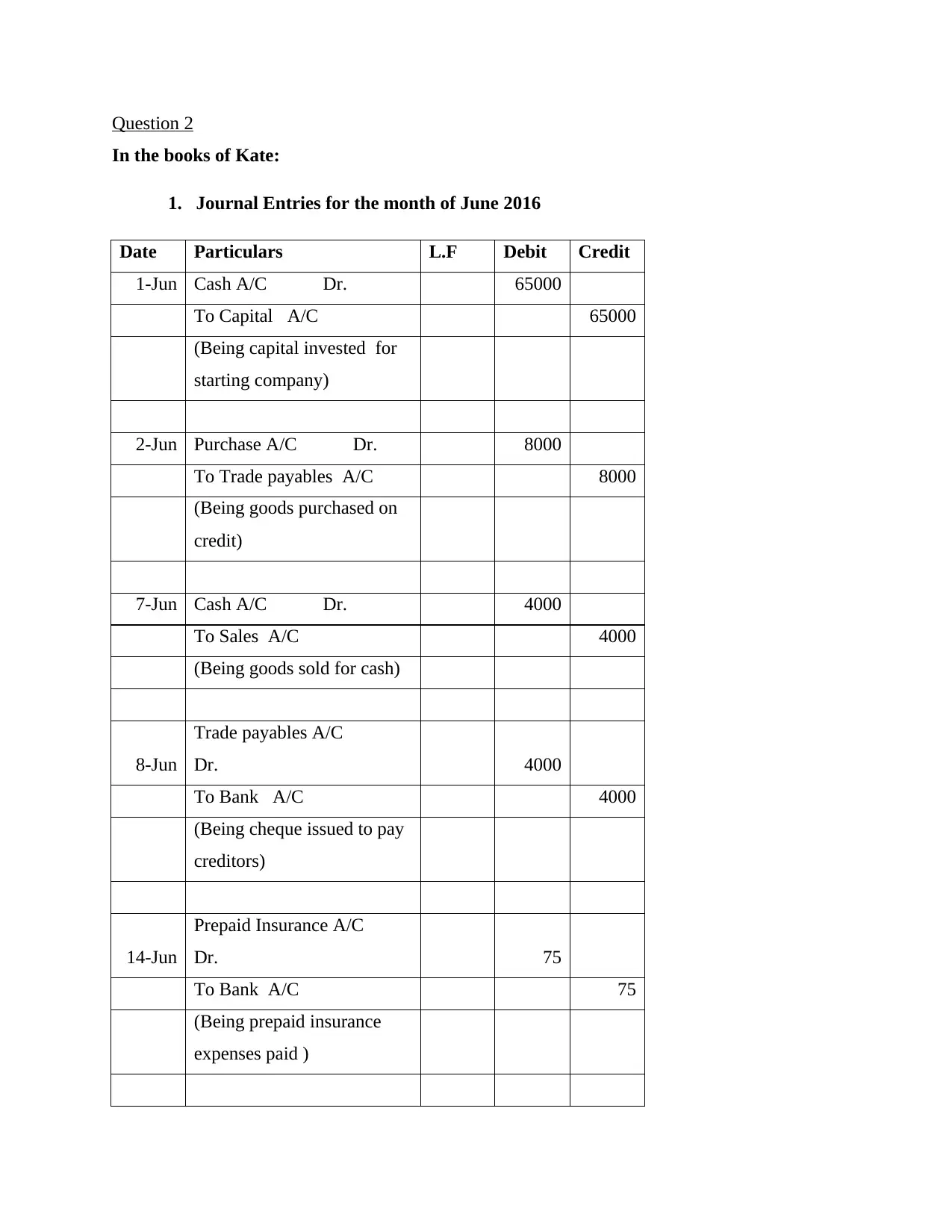
Question 2
In the books of Kate:
1. Journal Entries for the month of June 2016
Date Particulars L.F Debit Credit
1-Jun Cash A/C Dr. 65000
To Capital A/C 65000
(Being capital invested for
starting company)
2-Jun Purchase A/C Dr. 8000
To Trade payables A/C 8000
(Being goods purchased on
credit)
7-Jun Cash A/C Dr. 4000
To Sales A/C 4000
(Being goods sold for cash)
8-Jun
Trade payables A/C
Dr. 4000
To Bank A/C 4000
(Being cheque issued to pay
creditors)
14-Jun
Prepaid Insurance A/C
Dr. 75
To Bank A/C 75
(Being prepaid insurance
expenses paid )
In the books of Kate:
1. Journal Entries for the month of June 2016
Date Particulars L.F Debit Credit
1-Jun Cash A/C Dr. 65000
To Capital A/C 65000
(Being capital invested for
starting company)
2-Jun Purchase A/C Dr. 8000
To Trade payables A/C 8000
(Being goods purchased on
credit)
7-Jun Cash A/C Dr. 4000
To Sales A/C 4000
(Being goods sold for cash)
8-Jun
Trade payables A/C
Dr. 4000
To Bank A/C 4000
(Being cheque issued to pay
creditors)
14-Jun
Prepaid Insurance A/C
Dr. 75
To Bank A/C 75
(Being prepaid insurance
expenses paid )
Paraphrase This Document
Need a fresh take? Get an instant paraphrase of this document with our AI Paraphraser
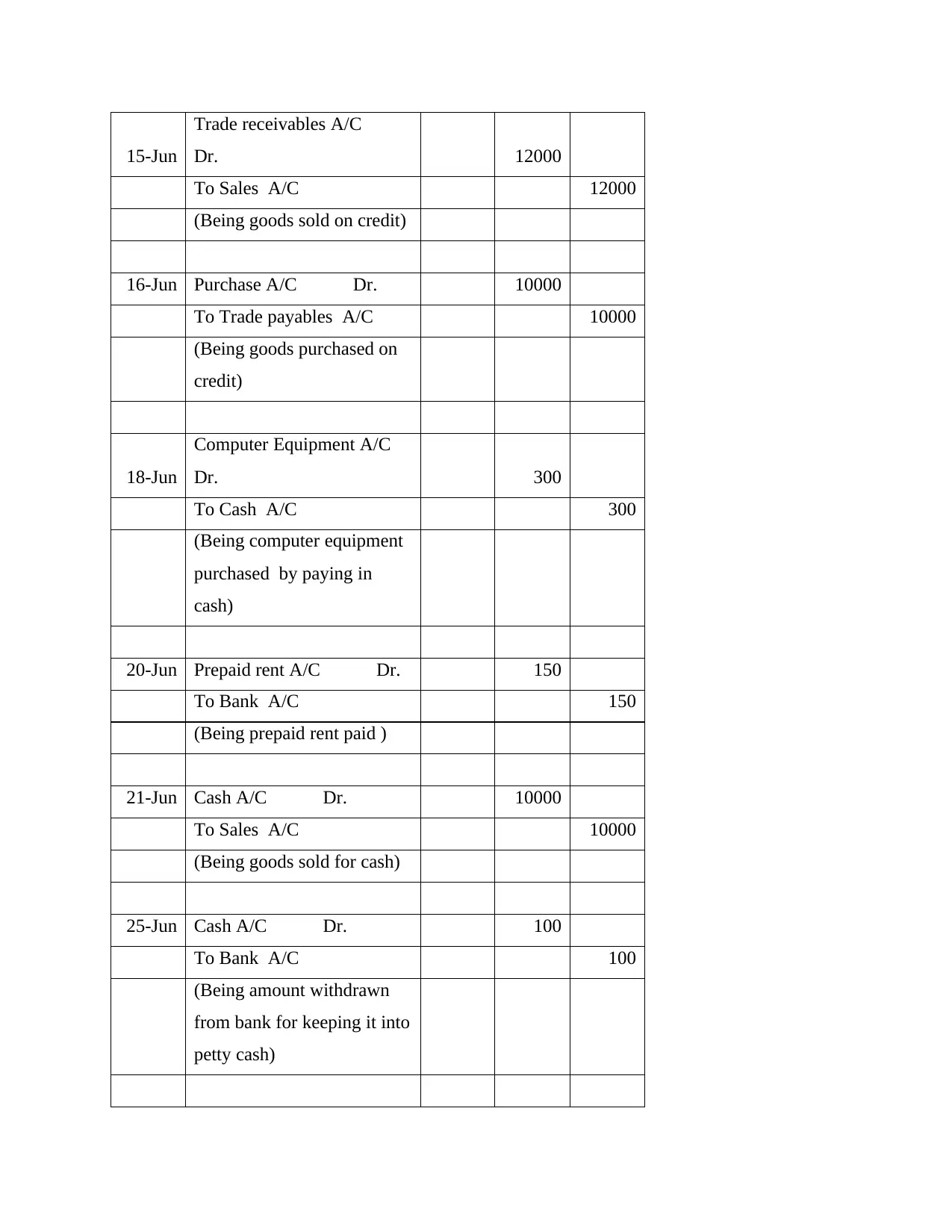
15-Jun
Trade receivables A/C
Dr. 12000
To Sales A/C 12000
(Being goods sold on credit)
16-Jun Purchase A/C Dr. 10000
To Trade payables A/C 10000
(Being goods purchased on
credit)
18-Jun
Computer Equipment A/C
Dr. 300
To Cash A/C 300
(Being computer equipment
purchased by paying in
cash)
20-Jun Prepaid rent A/C Dr. 150
To Bank A/C 150
(Being prepaid rent paid )
21-Jun Cash A/C Dr. 10000
To Sales A/C 10000
(Being goods sold for cash)
25-Jun Cash A/C Dr. 100
To Bank A/C 100
(Being amount withdrawn
from bank for keeping it into
petty cash)
Trade receivables A/C
Dr. 12000
To Sales A/C 12000
(Being goods sold on credit)
16-Jun Purchase A/C Dr. 10000
To Trade payables A/C 10000
(Being goods purchased on
credit)
18-Jun
Computer Equipment A/C
Dr. 300
To Cash A/C 300
(Being computer equipment
purchased by paying in
cash)
20-Jun Prepaid rent A/C Dr. 150
To Bank A/C 150
(Being prepaid rent paid )
21-Jun Cash A/C Dr. 10000
To Sales A/C 10000
(Being goods sold for cash)
25-Jun Cash A/C Dr. 100
To Bank A/C 100
(Being amount withdrawn
from bank for keeping it into
petty cash)
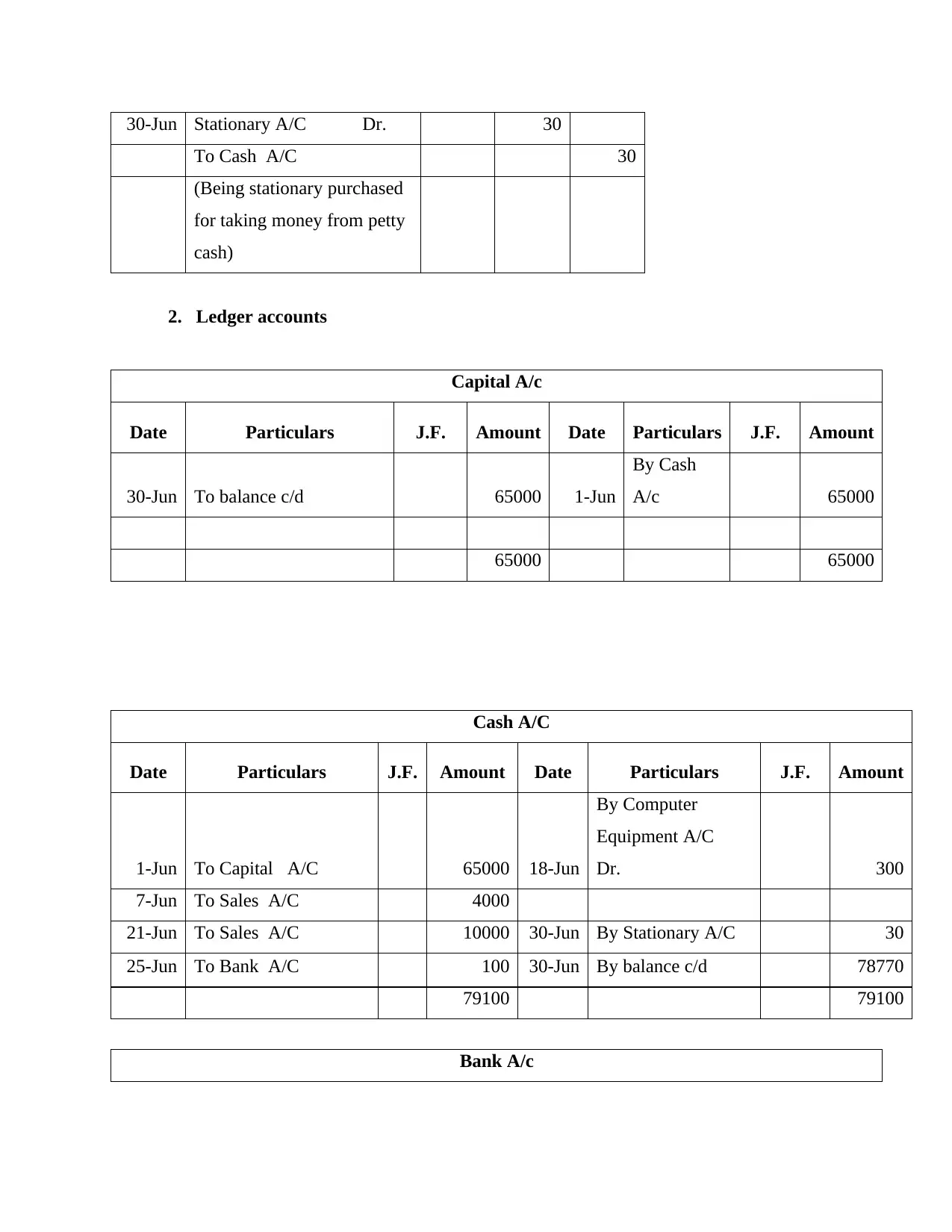
30-Jun Stationary A/C Dr. 30
To Cash A/C 30
(Being stationary purchased
for taking money from petty
cash)
2. Ledger accounts
Capital A/c
Date Particulars J.F. Amount Date Particulars J.F. Amount
30-Jun To balance c/d 65000 1-Jun
By Cash
A/c 65000
65000 65000
Cash A/C
Date Particulars J.F. Amount Date Particulars J.F. Amount
1-Jun To Capital A/C 65000 18-Jun
By Computer
Equipment A/C
Dr. 300
7-Jun To Sales A/C 4000
21-Jun To Sales A/C 10000 30-Jun By Stationary A/C 30
25-Jun To Bank A/C 100 30-Jun By balance c/d 78770
79100 79100
Bank A/c
To Cash A/C 30
(Being stationary purchased
for taking money from petty
cash)
2. Ledger accounts
Capital A/c
Date Particulars J.F. Amount Date Particulars J.F. Amount
30-Jun To balance c/d 65000 1-Jun
By Cash
A/c 65000
65000 65000
Cash A/C
Date Particulars J.F. Amount Date Particulars J.F. Amount
1-Jun To Capital A/C 65000 18-Jun
By Computer
Equipment A/C
Dr. 300
7-Jun To Sales A/C 4000
21-Jun To Sales A/C 10000 30-Jun By Stationary A/C 30
25-Jun To Bank A/C 100 30-Jun By balance c/d 78770
79100 79100
Bank A/c
⊘ This is a preview!⊘
Do you want full access?
Subscribe today to unlock all pages.

Trusted by 1+ million students worldwide
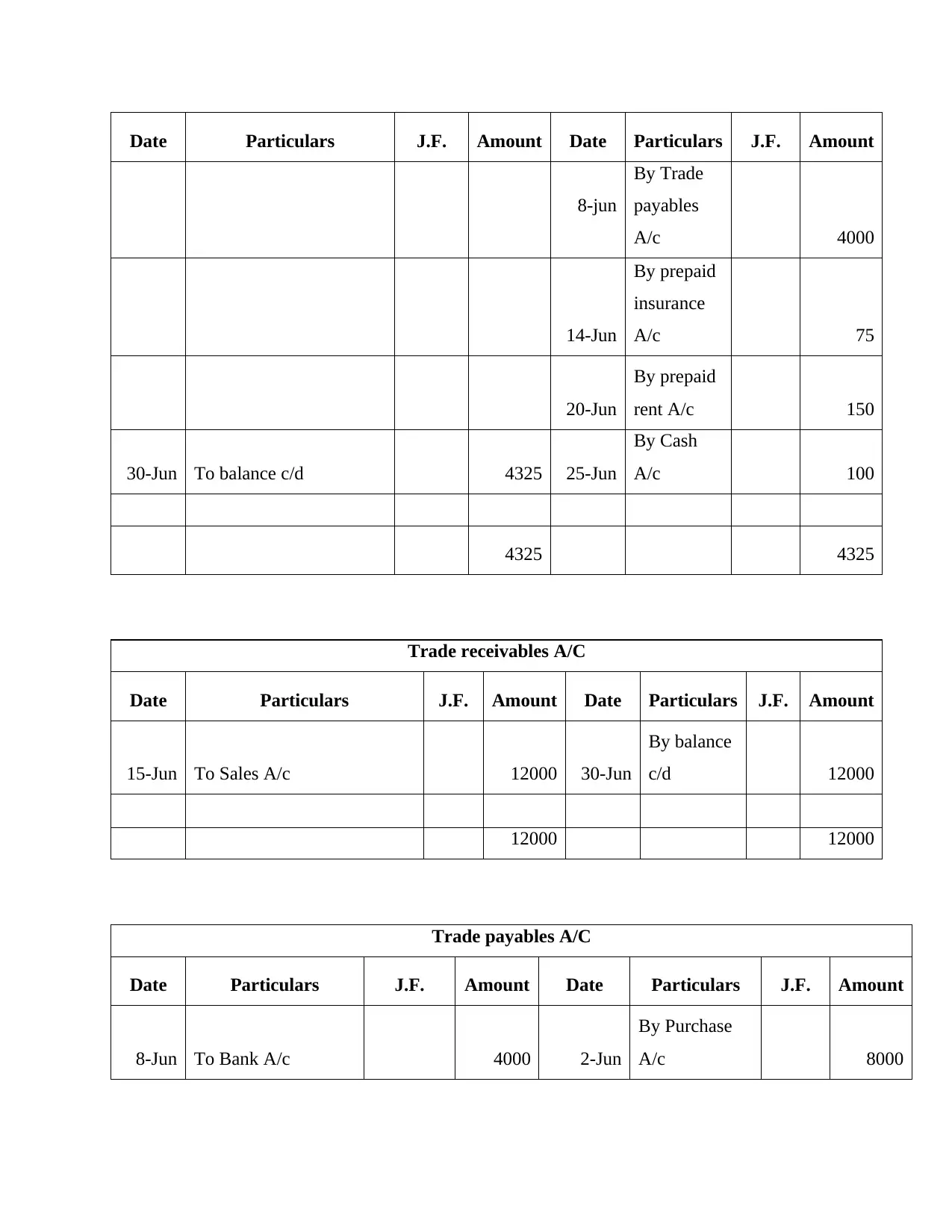
Date Particulars J.F. Amount Date Particulars J.F. Amount
8-jun
By Trade
payables
A/c 4000
14-Jun
By prepaid
insurance
A/c 75
20-Jun
By prepaid
rent A/c 150
30-Jun To balance c/d 4325 25-Jun
By Cash
A/c 100
4325 4325
Trade receivables A/C
Date Particulars J.F. Amount Date Particulars J.F. Amount
15-Jun To Sales A/c 12000 30-Jun
By balance
c/d 12000
12000 12000
Trade payables A/C
Date Particulars J.F. Amount Date Particulars J.F. Amount
8-Jun To Bank A/c 4000 2-Jun
By Purchase
A/c 8000
8-jun
By Trade
payables
A/c 4000
14-Jun
By prepaid
insurance
A/c 75
20-Jun
By prepaid
rent A/c 150
30-Jun To balance c/d 4325 25-Jun
By Cash
A/c 100
4325 4325
Trade receivables A/C
Date Particulars J.F. Amount Date Particulars J.F. Amount
15-Jun To Sales A/c 12000 30-Jun
By balance
c/d 12000
12000 12000
Trade payables A/C
Date Particulars J.F. Amount Date Particulars J.F. Amount
8-Jun To Bank A/c 4000 2-Jun
By Purchase
A/c 8000
Paraphrase This Document
Need a fresh take? Get an instant paraphrase of this document with our AI Paraphraser
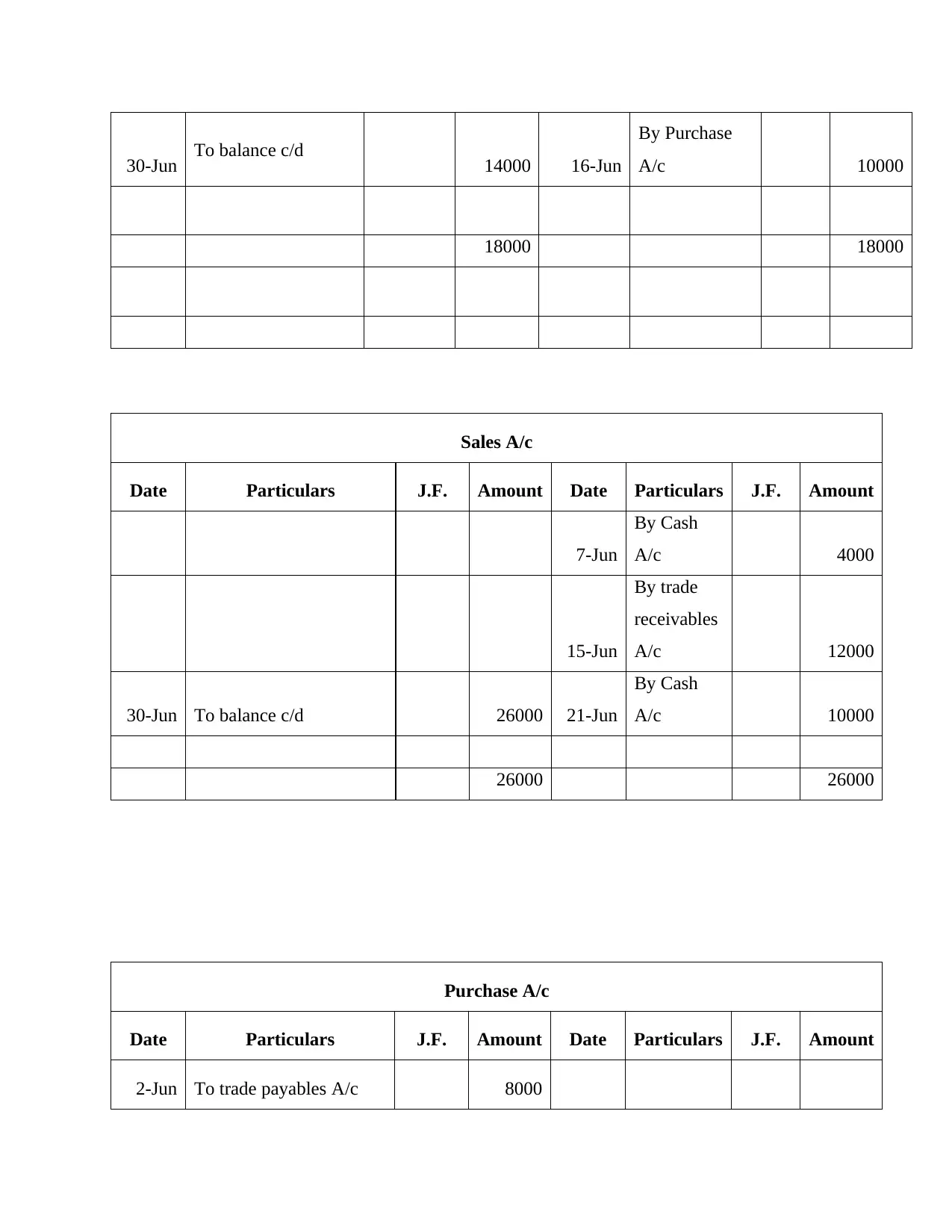
30-Jun To balance c/d 14000 16-Jun
By Purchase
A/c 10000
18000 18000
Sales A/c
Date Particulars J.F. Amount Date Particulars J.F. Amount
7-Jun
By Cash
A/c 4000
15-Jun
By trade
receivables
A/c 12000
30-Jun To balance c/d 26000 21-Jun
By Cash
A/c 10000
26000 26000
Purchase A/c
Date Particulars J.F. Amount Date Particulars J.F. Amount
2-Jun To trade payables A/c 8000
By Purchase
A/c 10000
18000 18000
Sales A/c
Date Particulars J.F. Amount Date Particulars J.F. Amount
7-Jun
By Cash
A/c 4000
15-Jun
By trade
receivables
A/c 12000
30-Jun To balance c/d 26000 21-Jun
By Cash
A/c 10000
26000 26000
Purchase A/c
Date Particulars J.F. Amount Date Particulars J.F. Amount
2-Jun To trade payables A/c 8000
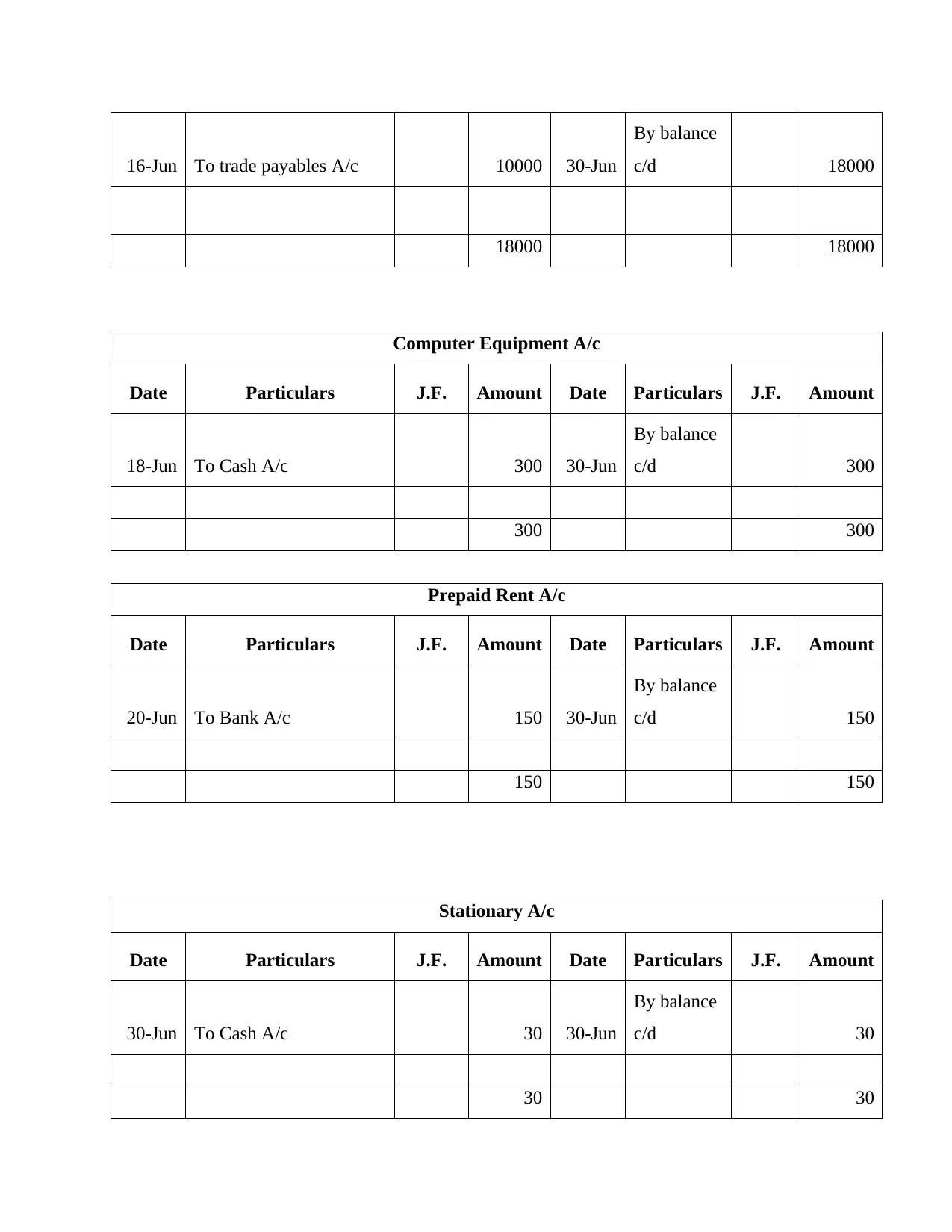
16-Jun To trade payables A/c 10000 30-Jun
By balance
c/d 18000
18000 18000
Computer Equipment A/c
Date Particulars J.F. Amount Date Particulars J.F. Amount
18-Jun To Cash A/c 300 30-Jun
By balance
c/d 300
300 300
Prepaid Rent A/c
Date Particulars J.F. Amount Date Particulars J.F. Amount
20-Jun To Bank A/c 150 30-Jun
By balance
c/d 150
150 150
Stationary A/c
Date Particulars J.F. Amount Date Particulars J.F. Amount
30-Jun To Cash A/c 30 30-Jun
By balance
c/d 30
30 30
By balance
c/d 18000
18000 18000
Computer Equipment A/c
Date Particulars J.F. Amount Date Particulars J.F. Amount
18-Jun To Cash A/c 300 30-Jun
By balance
c/d 300
300 300
Prepaid Rent A/c
Date Particulars J.F. Amount Date Particulars J.F. Amount
20-Jun To Bank A/c 150 30-Jun
By balance
c/d 150
150 150
Stationary A/c
Date Particulars J.F. Amount Date Particulars J.F. Amount
30-Jun To Cash A/c 30 30-Jun
By balance
c/d 30
30 30
⊘ This is a preview!⊘
Do you want full access?
Subscribe today to unlock all pages.

Trusted by 1+ million students worldwide
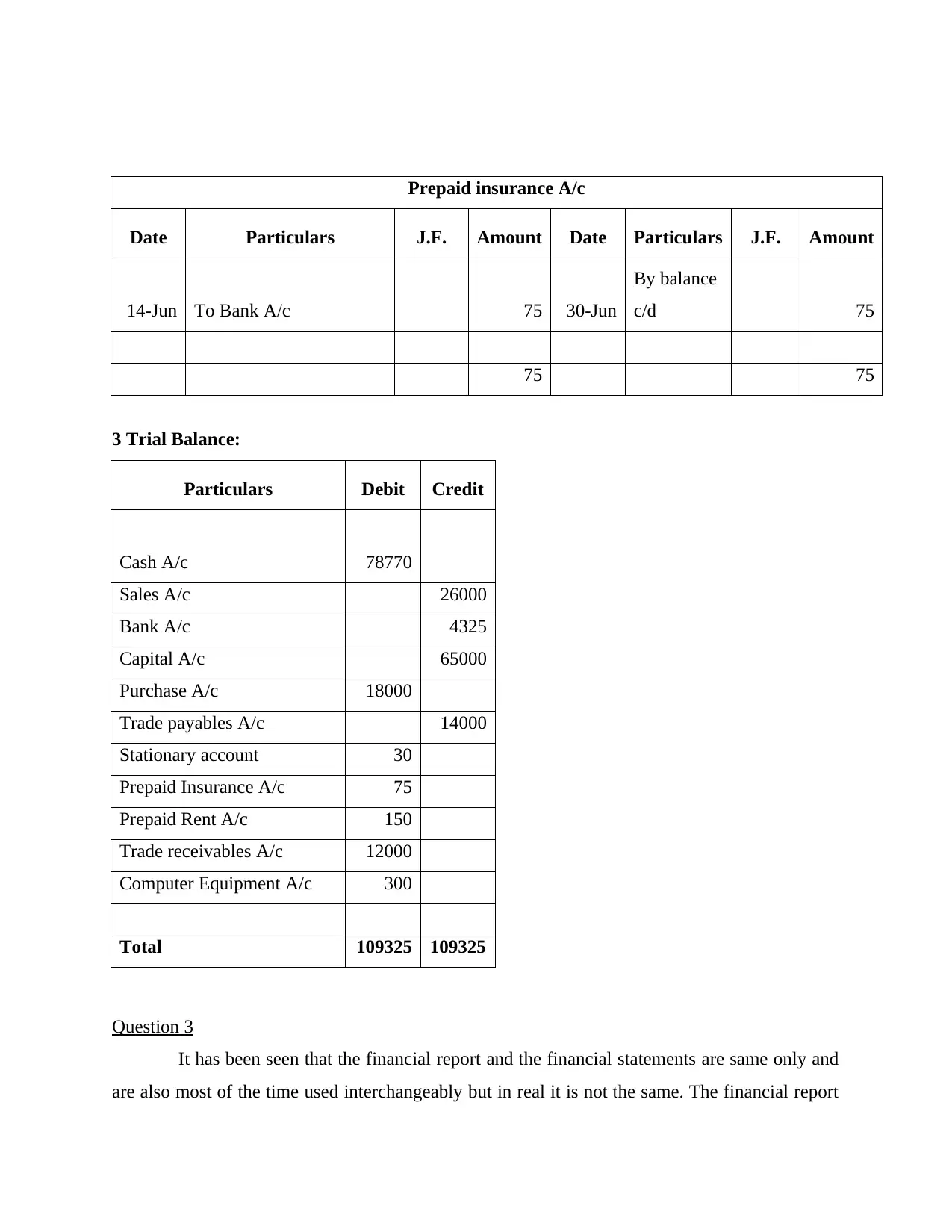
Prepaid insurance A/c
Date Particulars J.F. Amount Date Particulars J.F. Amount
14-Jun To Bank A/c 75 30-Jun
By balance
c/d 75
75 75
3 Trial Balance:
Particulars Debit Credit
Cash A/c 78770
Sales A/c 26000
Bank A/c 4325
Capital A/c 65000
Purchase A/c 18000
Trade payables A/c 14000
Stationary account 30
Prepaid Insurance A/c 75
Prepaid Rent A/c 150
Trade receivables A/c 12000
Computer Equipment A/c 300
Total 109325 109325
Question 3
It has been seen that the financial report and the financial statements are same only and
are also most of the time used interchangeably but in real it is not the same. The financial report
Date Particulars J.F. Amount Date Particulars J.F. Amount
14-Jun To Bank A/c 75 30-Jun
By balance
c/d 75
75 75
3 Trial Balance:
Particulars Debit Credit
Cash A/c 78770
Sales A/c 26000
Bank A/c 4325
Capital A/c 65000
Purchase A/c 18000
Trade payables A/c 14000
Stationary account 30
Prepaid Insurance A/c 75
Prepaid Rent A/c 150
Trade receivables A/c 12000
Computer Equipment A/c 300
Total 109325 109325
Question 3
It has been seen that the financial report and the financial statements are same only and
are also most of the time used interchangeably but in real it is not the same. The financial report
Paraphrase This Document
Need a fresh take? Get an instant paraphrase of this document with our AI Paraphraser
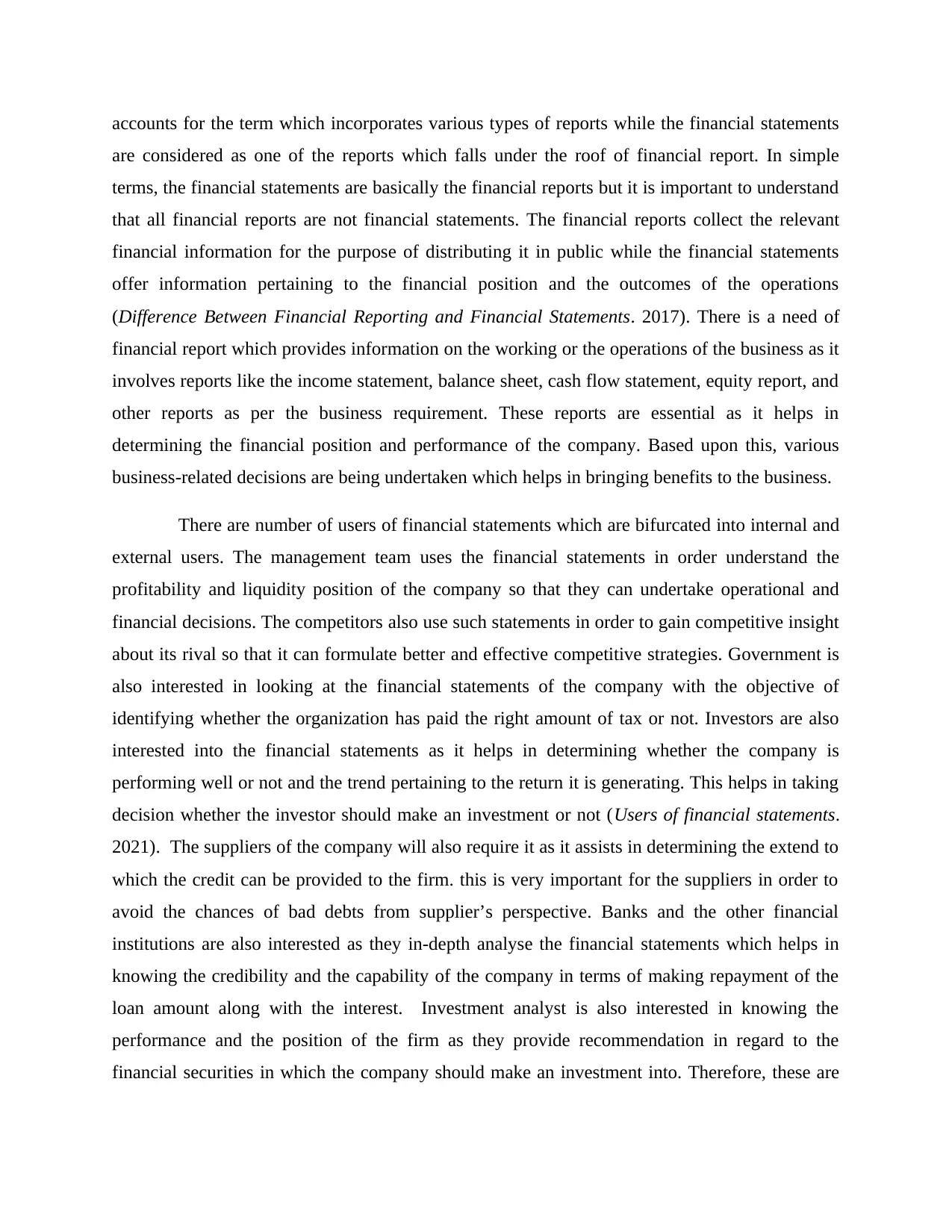
accounts for the term which incorporates various types of reports while the financial statements
are considered as one of the reports which falls under the roof of financial report. In simple
terms, the financial statements are basically the financial reports but it is important to understand
that all financial reports are not financial statements. The financial reports collect the relevant
financial information for the purpose of distributing it in public while the financial statements
offer information pertaining to the financial position and the outcomes of the operations
(Difference Between Financial Reporting and Financial Statements. 2017). There is a need of
financial report which provides information on the working or the operations of the business as it
involves reports like the income statement, balance sheet, cash flow statement, equity report, and
other reports as per the business requirement. These reports are essential as it helps in
determining the financial position and performance of the company. Based upon this, various
business-related decisions are being undertaken which helps in bringing benefits to the business.
There are number of users of financial statements which are bifurcated into internal and
external users. The management team uses the financial statements in order understand the
profitability and liquidity position of the company so that they can undertake operational and
financial decisions. The competitors also use such statements in order to gain competitive insight
about its rival so that it can formulate better and effective competitive strategies. Government is
also interested in looking at the financial statements of the company with the objective of
identifying whether the organization has paid the right amount of tax or not. Investors are also
interested into the financial statements as it helps in determining whether the company is
performing well or not and the trend pertaining to the return it is generating. This helps in taking
decision whether the investor should make an investment or not (Users of financial statements.
2021). The suppliers of the company will also require it as it assists in determining the extend to
which the credit can be provided to the firm. this is very important for the suppliers in order to
avoid the chances of bad debts from supplier’s perspective. Banks and the other financial
institutions are also interested as they in-depth analyse the financial statements which helps in
knowing the credibility and the capability of the company in terms of making repayment of the
loan amount along with the interest. Investment analyst is also interested in knowing the
performance and the position of the firm as they provide recommendation in regard to the
financial securities in which the company should make an investment into. Therefore, these are
are considered as one of the reports which falls under the roof of financial report. In simple
terms, the financial statements are basically the financial reports but it is important to understand
that all financial reports are not financial statements. The financial reports collect the relevant
financial information for the purpose of distributing it in public while the financial statements
offer information pertaining to the financial position and the outcomes of the operations
(Difference Between Financial Reporting and Financial Statements. 2017). There is a need of
financial report which provides information on the working or the operations of the business as it
involves reports like the income statement, balance sheet, cash flow statement, equity report, and
other reports as per the business requirement. These reports are essential as it helps in
determining the financial position and performance of the company. Based upon this, various
business-related decisions are being undertaken which helps in bringing benefits to the business.
There are number of users of financial statements which are bifurcated into internal and
external users. The management team uses the financial statements in order understand the
profitability and liquidity position of the company so that they can undertake operational and
financial decisions. The competitors also use such statements in order to gain competitive insight
about its rival so that it can formulate better and effective competitive strategies. Government is
also interested in looking at the financial statements of the company with the objective of
identifying whether the organization has paid the right amount of tax or not. Investors are also
interested into the financial statements as it helps in determining whether the company is
performing well or not and the trend pertaining to the return it is generating. This helps in taking
decision whether the investor should make an investment or not (Users of financial statements.
2021). The suppliers of the company will also require it as it assists in determining the extend to
which the credit can be provided to the firm. this is very important for the suppliers in order to
avoid the chances of bad debts from supplier’s perspective. Banks and the other financial
institutions are also interested as they in-depth analyse the financial statements which helps in
knowing the credibility and the capability of the company in terms of making repayment of the
loan amount along with the interest. Investment analyst is also interested in knowing the
performance and the position of the firm as they provide recommendation in regard to the
financial securities in which the company should make an investment into. Therefore, these are
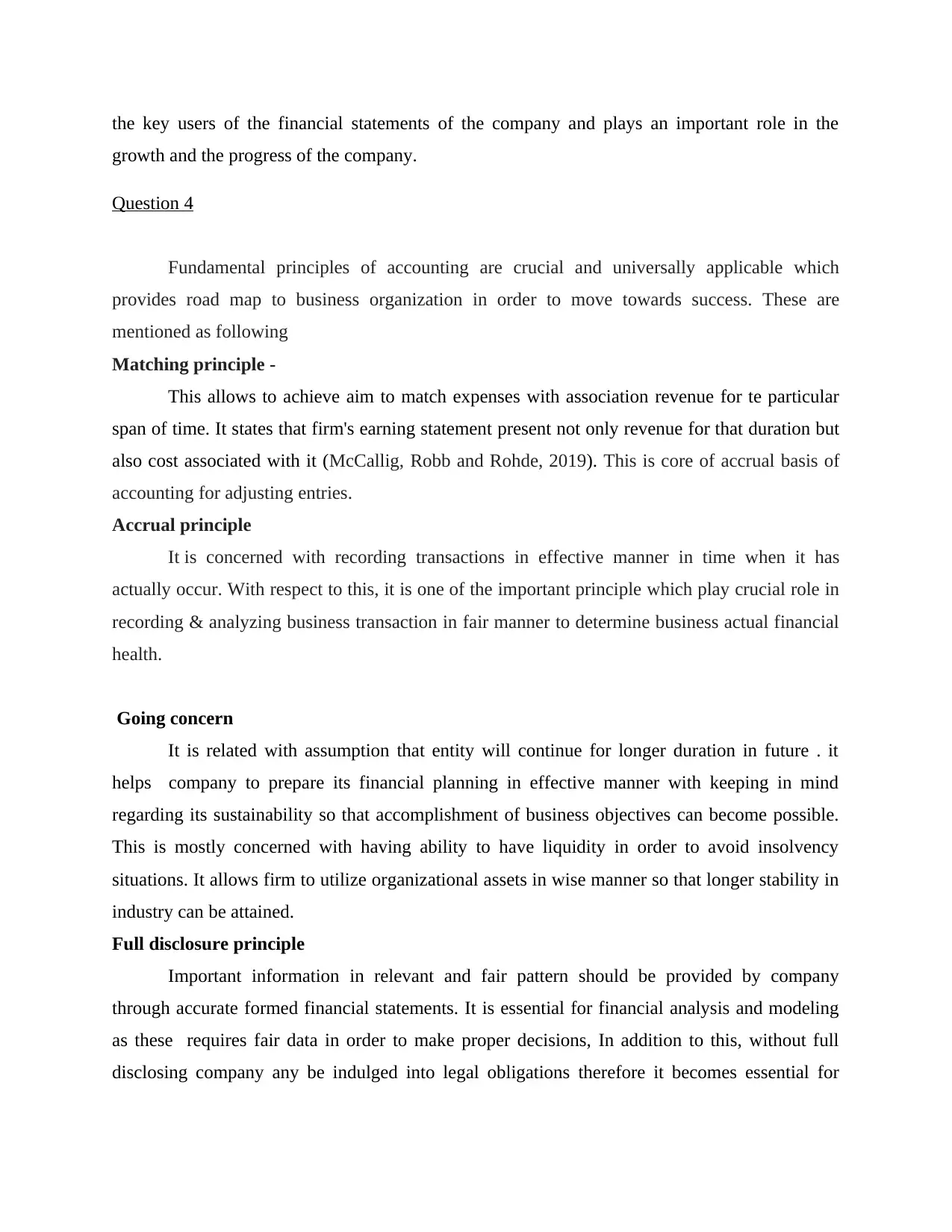
the key users of the financial statements of the company and plays an important role in the
growth and the progress of the company.
Question 4
Fundamental principles of accounting are crucial and universally applicable which
provides road map to business organization in order to move towards success. These are
mentioned as following
Matching principle -
This allows to achieve aim to match expenses with association revenue for te particular
span of time. It states that firm's earning statement present not only revenue for that duration but
also cost associated with it (McCallig, Robb and Rohde, 2019). This is core of accrual basis of
accounting for adjusting entries.
Accrual principle
It is concerned with recording transactions in effective manner in time when it has
actually occur. With respect to this, it is one of the important principle which play crucial role in
recording & analyzing business transaction in fair manner to determine business actual financial
health.
Going concern
It is related with assumption that entity will continue for longer duration in future . it
helps company to prepare its financial planning in effective manner with keeping in mind
regarding its sustainability so that accomplishment of business objectives can become possible.
This is mostly concerned with having ability to have liquidity in order to avoid insolvency
situations. It allows firm to utilize organizational assets in wise manner so that longer stability in
industry can be attained.
Full disclosure principle
Important information in relevant and fair pattern should be provided by company
through accurate formed financial statements. It is essential for financial analysis and modeling
as these requires fair data in order to make proper decisions, In addition to this, without full
disclosing company any be indulged into legal obligations therefore it becomes essential for
growth and the progress of the company.
Question 4
Fundamental principles of accounting are crucial and universally applicable which
provides road map to business organization in order to move towards success. These are
mentioned as following
Matching principle -
This allows to achieve aim to match expenses with association revenue for te particular
span of time. It states that firm's earning statement present not only revenue for that duration but
also cost associated with it (McCallig, Robb and Rohde, 2019). This is core of accrual basis of
accounting for adjusting entries.
Accrual principle
It is concerned with recording transactions in effective manner in time when it has
actually occur. With respect to this, it is one of the important principle which play crucial role in
recording & analyzing business transaction in fair manner to determine business actual financial
health.
Going concern
It is related with assumption that entity will continue for longer duration in future . it
helps company to prepare its financial planning in effective manner with keeping in mind
regarding its sustainability so that accomplishment of business objectives can become possible.
This is mostly concerned with having ability to have liquidity in order to avoid insolvency
situations. It allows firm to utilize organizational assets in wise manner so that longer stability in
industry can be attained.
Full disclosure principle
Important information in relevant and fair pattern should be provided by company
through accurate formed financial statements. It is essential for financial analysis and modeling
as these requires fair data in order to make proper decisions, In addition to this, without full
disclosing company any be indulged into legal obligations therefore it becomes essential for
⊘ This is a preview!⊘
Do you want full access?
Subscribe today to unlock all pages.

Trusted by 1+ million students worldwide
1 out of 25
Related Documents
Your All-in-One AI-Powered Toolkit for Academic Success.
+13062052269
info@desklib.com
Available 24*7 on WhatsApp / Email
![[object Object]](/_next/static/media/star-bottom.7253800d.svg)
Unlock your academic potential
Copyright © 2020–2025 A2Z Services. All Rights Reserved. Developed and managed by ZUCOL.





